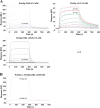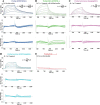Structural insights into cargo recognition by the yeast PTS1 receptor
- PMID: 26359497
- PMCID: PMC4646318
- DOI: 10.1074/jbc.M115.657973
Structural insights into cargo recognition by the yeast PTS1 receptor
Abstract
The peroxisomal matrix protein import is facilitated by cycling import receptors that shuttle between the cytosol and the peroxisomal membrane. The import receptor Pex5p mediates the import of proteins harboring a peroxisomal targeting signal of type I (PTS1). Purified recombinant Pex5p forms a dimeric complex with the PTS1-protein Pcs60p in vitro with a KD of 0.19 μm. To analyze the structural basis for receptor-cargo recognition, the PTS1 and adjacent amino acids of Pcs60p were systematically scanned for Pex5p binding by an in vitro site-directed photo-cross-linking approach. The cross-linked binding regions of the receptor were subsequently identified by high resolution mass spectrometry. Most cross-links were found with TPR6, TPR7, as well as the 7C-loop of Pex5p. Surface plasmon resonance analysis revealed a bivalent interaction mode for Pex5p and Pcs60p. Interestingly, Pcs60p lacking its C-terminal tripeptide sequence was efficiently cross-linked to the same regions of Pex5p. The KD value of the interaction of truncated Pcs60p and Pex5p was in the range of 7.7 μm. Isothermal titration calorimetry and surface plasmon resonance measurements revealed a monovalent binding mode for the interaction of Pex5p and Pcs60p lacking the PTS1. Our data indicate that Pcs60p contains a second contact site for its receptor Pex5p, beyond the C-terminal tripeptide. The physiological relevance of the ancillary binding region was supported by in vivo import studies. The bivalent binding mode might be explained by a two-step concept as follows: first, cargo recognition and initial tethering by the PTS1-receptor Pex5p; second, lock-in of receptor and cargo.
Keywords: mass spectrometry (MS); peroxisome; protein cross-linking; protein targeting; protein translocation; protein-protein interaction; yeast.
© 2015 by The American Society for Biochemistry and Molecular Biology, Inc.
Figures










References
-
- Theodoulou F. L., Bernhardt K., Linka N., and Baker A. (2013) Peroxisome membrane proteins: multiple trafficking routes and multiple functions? Biochem. J. 451, 345–352 - PubMed
-
- Lazarow P. B., and Fujiki Y. (1985) Biogenesis of peroxisomes. Annu. Rev. Cell Biol. 1, 489–530 - PubMed
-
- Meinecke M., Cizmowski C., Schliebs W., Krüger V., Beck S., Wagner R., and Erdmann R. (2010) The peroxisomal importomer constitutes a large and highly dynamic pore. Nat. Cell Biol. 12, 273–277 - PubMed
Publication types
MeSH terms
Substances
Associated data
- Actions
LinkOut - more resources
Full Text Sources
Molecular Biology Databases

